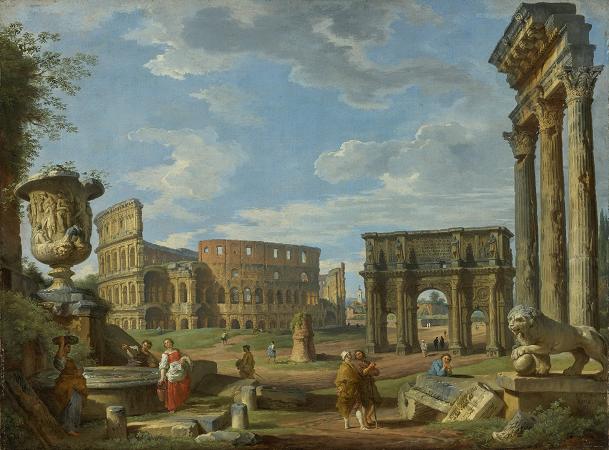San Clemente al Laterano. The Basilica of Saint Clement is a Roman Catholic minor basilica dedicated to Pope Clement I located in Rome, Italy. Archaeologically speaking, the structure is a three-tiered complex of buildings: the present basilica built just before the year 1100 during the height of the Middle Ages; beneath the present basilica is a 4th-century basilica that had been converted out of the home of a Roman nobleman, part of which had in the 1st century briefly served as an early church, and the basement of which had in the 2nd century briefly served as a mithraeum; the home of the Roman nobleman had been built on the foundations of republican era villa and warehouse that had been destroyed in the Great Fire of 64 AD. This ancient church was transformed over the centuries from a private home that was the site of clandestine Christian worship in the 1st century to a grand public basilica by the 6th century, reflecting the emerging Catholic Church's growing legitimacy and power. The archaeological traces of the basilica's history were discovered in the 1860s by Joseph Mullooly, Prior of the house of Irish Dominicans at San Clemente. The lowest levels of the present basilica contain remnants of the foundation of a possibly republican era building that might have been destroyed in the Great Fire of 64. An industrial building-probably the imperial mint of Rome from the late 1st century A.D. onwards, was built or remodelled on the same site during the Flavian period. Shortly after an insula, or apartment block, was also built. It was separated from the industrial building by a narrow alleyway. About a hundred years later a mithraeum, a sanctuary of the cult of Mithras, was built in the courtyard of the insula. The main cult room, which is about 9.6m long and 6m wide, was discovered in 1867 but could not be investigated until 1914 due to lack of drainage. The exedra, the shallow apse at the far end of the low vaulted space, was trimmed with pumice to render it more cave-like. Central to the main room of the sanctuary was found an altar, in the shape of a sarcophagus, and with the main cult relief of the tauroctony on its front face. The torchbearers Cautes and Cautopates appear on respectively the left and right faces of the same monument. A dedicatory inscription identifies the donor as one pater Cnaeus Arrius Claudianus, perhaps of the same clan as Titus Arrius Antoninus' mother. Other monuments discovered in the sanctuary include a bust of Sol kept in the sanctuary in a niche near the entrance, and a figure of Mithras petra generix, i.e. Mithras born of the rock. Fragments of statuary of the two torch bearers were also found. One of the rooms adjoining the main chamber has two oblong brickwork enclosures, one of which was used as a ritual refuse pit for remnants of the cult meal. All three monuments mentioned above are still on display in the mithraeum. A fourth monument,-a statue of St. Peter found in the speleum's vestibule and still on display there-is not of the mysteries. At some time in the 4th century, the lower level of the industrial building was filled in with dirt and rubble and its second floor remodeled. An apse was built out over part of the domus, whose lowest floor, with the Mithraeum, was also filled in. This first basilica is known to have existed in 392, when St. Jerome wrote of the church dedicated to St. Clement, i.e. Pope Clement I, a 1st-century AD Christian convert and previously considered by patrologists and ecclesiastical historians to be identical with Titus Flavius Clemens. Restorations were undertaken in the 9th century and ca 1080-99. The early basilica was the site of councils presided over by Pope Zosimus and Symmachus. The last major event that took place in the lower basilica was the election in 1099 of Cardinal Rainerius of St Clemente as Pope Paschal II. Apart from those in Santa Maria Antiqua, the largest collection of Early Medieval wall paintings in Rome is to be found in the lower basilica of San Clemente. Four of the largest frescoes in the basilica were sponsored by a lay couple, Beno de Rapiza and Maria Macellaria, at some time in the last third of the 11th century and focus on the life, miracles, and translation of St. Clement, and on the life of St. Alexius. Beno and Maria are shown in two of the compositions, once on the facade of the basilica together with their children, Altilia and Clemens, offering gifts to St. Clement, and on a pillar on the left side of the nave, where they are portrayed on a small scale witnessing a miracle performed by St. Clement. Below this last scene is one of the earliest examples of the passage from Latin to vernacular Italian: a fresco of the pagan Sisinnius and his servants, who think they have captured St. Clement but are dragging a column instead.
more...




